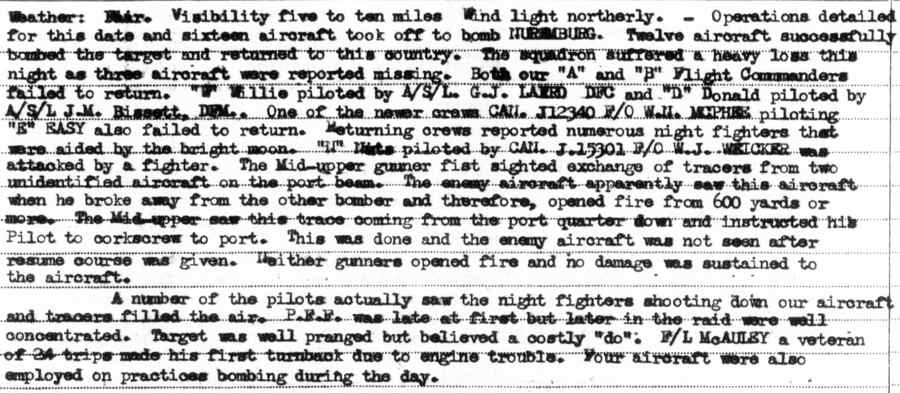 Bomber Command
Bomber Command  |
Aircrew Chronicles
|
Aircrew Losses
|
Nose Art
|
BCATP
|
Lancaster
|
Media
|
Aircrew Chronicles
|
Aircrew Losses
|
Nose Art
|
BCATP
|
Lancaster
|
Media
 Bomber Command
Bomber Command  |
Aircrew Chronicles
|
Aircrew Losses
|
Nose Art
|
BCATP
|
Lancaster
|
Media
|
Aircrew Chronicles
|
Aircrew Losses
|
Nose Art
|
BCATP
|
Lancaster
|
Media
Significant Operations
Bomber Command
On the clear, moonlit night of 30/31 March 1944, Bomber Command launched a 'maximum effort' raid on Nuremberg. It was planned on the basis of an early forecast that there would be protective high cloud on the outward route when the moon would be up, but that the target area would be clear for ground-marked bombing. Prior to take-off time for the bombers, a Meteorological Flight Mosquito carried out a reconnaissance and reported that the protective cloud was unlikely to be present and that there could be cloud over the target, but the raid was not cancelled.
795 aircraft were dispatched -572 Lancasters, 214 Halifaxes and 9 Mosquitos. As predicted, the cloud that it was hoped would shield the bombers on their outward journey failed to materialize and a crystal-clear night greeted the airmen. To make matters worse, the normally invisible steam from the engine's exhaust condensed, creating clearly-visible trails in the sky.
The first fighters appeared just before the bombers reached the Belgian border and a fierce battle in the moonlight lasted for the next hour. 82 bombers were lost on the outward route and near the target. The action was much reduced on the return flight, when most of the German fighters had to land, but 95 bombers were lost in all -64 Lancasters and 31 Halifaxes, 11.9 per cent of the force dispatched. It was Bomber Command's biggest loss of the war.
The Canadian squadrons contributed 133 aircraft to the force, and off these, thirteen bombers were lost. The Leeming-based squadrons, 427 and 429, were particularly hard-hit, each losing three aircraft. Both of 427 Squadron's flight commanders failed to return.
The Nuremberg Raid was a disastrous end to the overall campaign known as the 'Battle of Berlin'.


